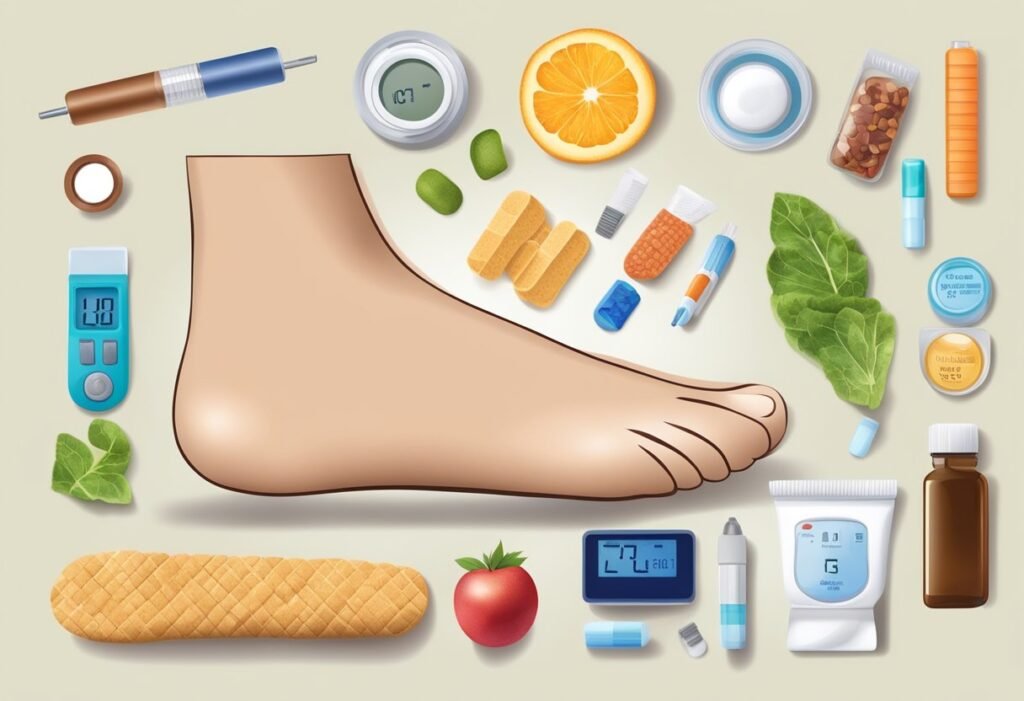Diabetics are at a higher risk of experiencing foot issues of any intensity, ranging from a mere inconvenience to a critical complication. Two main issues cause these complications: diabetic secondary complication such as diabetic neuropathy which is damage resulting from high blood sugar and peripheral vascular disease which compromise blood flow to the limbs. A common issue of peripheral neuropathy is that nerves in the legs and feet can become damaged and cause a lack of sensation and the inability to feel the initial sensations of irritation or pressure.
Diabetes cause alteration in gait and beading movement and therefore callus formation is rife among people with diabetes. In essence, although calluses may not be problematic to most individuals, they are dangerous conditions for diabetic patients. With decreased perception of pain, small injuries on the foot may not be felt or initially ignored culminating into infections and ulcers.
Diabetes patients particularly should ensure they have proper foot care to avoid any sad event happening to them. These comprise of foot examinations from a professional, caring for foot cleanliness, proper footwear wear, and managing blood glucose since it has an impact on the health of nerves as well as blood vessels. Diabetics also require care for even small issues like calluses on the foot as this may lead to other severe health complications.

Calluses and Diabetes
Calluses on the feet are more prevalent in diabetic patients. Some calluses may as a result develop into more dangerous conditions if not well handled.
Formation of Calluses
Diabetic Calluses are formed on patients’ feet as a result of pressures that are mostly noted at the bottom of the feet. A combination of these areas can be due to uneven weight distribution of the body or skin diseases. The condition of diabetes tends to deprive the skin of essential moisture and this gives rise to callus formation owing to cracking of the skin. Another factor to this is the existence of peripheral neuropathy which is an implication of nerve damage and is usually seen in diabetic patients. This removes sensitivity in the feet, thus pressure, injuries, and other dangerous signs go unnoticed.
- Causes:
- Altered foot biomechanics
- Loss of fatty padding in foot
- Poorly fitting footwear
Complications
Sometimes, the callus may not be just a nuisance to the diabetes but it may progress up to a stage of forming ulcers and infections. Peripheral arterial disease, which is characterized as reduced blood flow, intensifies it because it slows the healing process. Infections of the calluses turn into cellulitis or osteomyelitis which are serious conditions that need medical attention.
- Risks:
- Skin breakdown leading to ulcers
- Higher chance of infection
- Possible development of Charcot foot which is a very serious condition that will cause deformity of the foot.
Preventing and Treating Calluses

Callus formation is a common condition that necessitates good foot hygiene among diabetic patients’; therefore, appropriate care for feet is crucial to prevent formation of calluses and manage the existing ones. These are general check on the feet, medical treatment for the extreme cases and preventive measures.
Foot Care Recommendations
People with diabetes need to look at their feet every day for callus development, and injuries that would include cuts, blisters or sores. Using a lotion to soften the skin on the feet is essential, but patients are advised not to apply the lotion between the toes for risk of contracting a disease. Also, while choosing foot care products, the American Diabetes Association advises against products that contain acids to remove calluses as the risk of them is high.
- Daily Foot Inspection: Check for signs of calluses, skin changes, or injuries.
- Moisturize: Keep skin supple to prevent cracking, but avoid areas between toes.
As for footwear, one should wear shoes that fit well and do not press on specific zones; nails, in particular, should be cut in such a manner that there will be no angles to cause callous formation.
- Shoe Selection: Opt for well-fitting, comfortable footwear.
- Nail Care: Trim nails straight across to mitigate callus formation.
Medical Treatments
In the more serious cases, a podiatrist may shave the callus, that is, remove a part of the hardened skin since this could lead to formation of ulcers. Podiatric surgery may be necessary in cases where some foot structures like bunions or hammertoes cause callus, for offloading devices or corrective surgeries.
- Podiatric Debridement: Professional removal of skin condition thus being thickened.
- Corrective Devices or Surgery: To address underlying structural causes.
Diabetic patients should avoid the fact of using the notorious gesture, cutting calluses on your own due to the high risk of the development of various infections and complications. One should also maintain proper glycemic control to be of assistance to general foot health and also avoid the possibilities of nerve injury that tends to result to callus formation.
When to See a Doctor
There are certain complications that are more common in persons with diabetes and as such, foot care should be given topmost priorities. Daily foot checks are important and an individual should consult a doctor if the following signs occur.
Immediate medical attention is warranted if one notices:
- Persistent pain: Heling discomfort is present regularly and wire like throbbing of the feet usually persisting.
- Change in skin color: Slight change of color of the feet or toes most especially a dark cue.
- Changes in temperature: Feet getting intolerably cold or hot, without any other signs of illness.
- Wounds or sores: Chronic injuries that either do not heal or get aggravated.
- Infections: Swelling, redness, heat or pus at the site of the affected area or wound.
Additional symptoms that might require a doctor’s consultation are:
- Tingling or numbness: Tingling or numbness which is also known as paraesthesia.
- Inflammation and pain in the legs around the foot and ankle region..
- Any lesion involving the skin particularly if this is cracked or fissured or if the crack is deep.
- Thick, yellow nails especially those at the end of the toes that might signify a fungal infection.
- Thinning of the hair on the toes, feet and lower legs indicating poor blood circulation.
Doctors specializing in foot care, such as podiatrists, are equipped to handle diabetic foot-related issues more Diabetic foot related problems can be managed in a better manner by the physicians in the field of foot care namely podiatrists..
Key precautions for those with diabetes include:
- Looking for signs such as sores, break in the skin or any other abnormality on the feet.
- Staying as close to the target for blood sugar levels as possible..
- It is an aspect of footwear wherein people are advised to wear well-fitting shoes and refrain from walking shoeless.
For those with calluses, careful management is critical to prevent more serious conditions. It is essential to never attempt to cut calluses oneself as this can lead to infections or ulcers. Professional care is strongly advised for callus treatment.
Frequently Asked Questions
Within this part, I answer some of the frequently asked question and present the evidence concerning callus formation in diabetes mellitus, the approach to treatment, distinction between it and other diabetic foot conditions, the early marker of complications, safety measures, and preventive strategies for foot care in diabetes.
What are the recommended treatments for calluses on diabetic feet?
Diabetic patients whose skin develops calluses require professional treatment from a doctor or any other qualified personnel. They may prescribe them therapeutic shoes, orthotics or qualify to have the callus reduce partially by a podiatrist in order to avert formation of ulcers.
How do diabetic calluses differ in appearance from non-diabetic calluses?
Hyperbaric calluses in the diabetic patients tend to develop more quickly and may have a buildup that gives the appearance of being thicker over the foot. If not controlled these areas may result to formation of foot ulcers.
What are the signs of diabetic foot complications in the early stages?
Some of the first symptoms people with diabetes may experience about foot complications are experiencing pain, the reddening of the skin, inflammation, and variations in the color of the skin. Hence, any of these signs should be addressed at an early stage to avoid any progression of the disease.
Can diabetics safely use over-the-counter callus removers, and if not, why?
Normally, diabetics are cautioned against the use of the readily available callus removers chemicals that are used are often are inflammatory agents that if they cause injuries and breakages they take longer to heal. With diabetes, sensations in the feet are numbed, and thus the individual cannot feel such injuries when they occurs.
What are the best practices for diabetic foot ulcer prevention and care?
The preventive measures of diabetic foot ulcers are inspection of foot, management of diabetes, proper shoe wear and foot care. In this case, medical attention is required as soon as possible to decrease the likelihood of infection and the possible amputation of the affected area.
Why are diabetics more prone to developing calluses on their feet?
Diabetic patients are particularly susceptible to callus formation because of peripheral neuropathy which tends to cause a lack of feeling in the feet and impaired circulation that also predisposes an individual to changes in the pressure distribution when walking, this leading to the development of callus where pressures are intense.








1 thought on “Diabetes and Calluses on Feet”
Comments are closed.